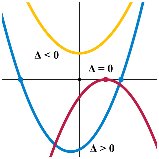|
|
|
|
|
|||||||||||
|
|
|||||||||||||||

UNIT
2 : FUNCTIONS & TRANSFORMATIONS
LESSON 4: REFLECTIONS HOMEWORK
QUESTIONS
1. Given the basic function
y = g(x) with graph below, use
transformations to sketch the graph of –g(x).

2. Given the basic function
y = g(x) with graph below, use
transformations to sketch the graph of g(-x).

3. In each case below, the red graph is a reflection of the blue graph. Use transformations to determine the equation of each graph.
a) 
b)

c)

d)

![]()
![]()
Solutions:
1. Given the basic function
y = g(x) with graph below, use
transformations to sketch the graph of –g(x).
Solution: The graph will be
a reflection in the x-axis relative to the basic function g(x) . In mapping form we have:
 (x, y) ---------------------------à(x , -y) and taking key points from the graph,
we obtain the points for the transformed function -g(x)
(x, y) ---------------------------à(x , -y) and taking key points from the graph,
we obtain the points for the transformed function -g(x)
(-5, 0)
--------------------------à(-5,0)
(-4, 1)
---------------------------à(-4,-1)
(-2, 1)
---------------------------à(-2,-1)
(0, 4) ----------------------------à (0, -4)
(2, -1) ---------------------------à (2,1)
(4, -1) ---------------------------à (4,1)
(5, 0) ----------------------------à (5,0) yielding the graph at left below for – g(x)

2. Given the basic function
y = g(x) with graph below, use
transformations to sketch the graph of g(-x).
Solution: The graph will be
a reflection in the y-axis relative to the basic function g(x) . In mapping form we have:
 (x, y) ---------------------------à(-x , y) and taking key points from the graph,
we obtain the points for the transformed function -g(x)
(x, y) ---------------------------à(-x , y) and taking key points from the graph,
we obtain the points for the transformed function -g(x)
(-5, 0)
--------------------------à(5,0)
(-4, 1)
---------------------------à(4,1)
(-2, 1)
---------------------------à(2,1)
(0, 4) ----------------------------à (0, 4)
(2, -1) ---------------------------à (-2,-1)
(4, -1) ---------------------------à (-4,-1)
(5, 0) ----------------------------à (-5,0) yielding the graph at left below for g(-x)

3. In each case below, the red graph is a reflection of the blue graph. Use transformations to determine the equation of each graph.
a) 

b)


c)


d)



 Draw
the graph of y = 2x + 1 by completing the tables of values below.
Draw
the graph of y = 2x + 1 by completing the tables of values below.
For y = 2x + 1
If x = -2, y = 2(-2) + 1 = -3
If x = -1, y = 2(-1) + 1= -1, etc. giving
|
x |
-2 |
-1 |
0 |
1 |
2 |
|
y |
-3 |
-1 |
1 |
3 |
5 |
For y = -2x + 1, the graph will be a reflection of y = 2x + 1 in the y-axis. In mapping form
(x, y) --------------------------à(-x, y) and using the points from the table above we have
(-2, -3) --------------------à (2, -3)
(-1, -1) --------------------à(1, -1)
(0, 1) --------------------à (0, 1)
(1, 3) --------------------à (-1, 3)
(2, 5) --------------------à (-2, 5)
Now to find –f(x):
-f(x) = -(2x + 1) = -2x – 1
or y
= -2x –1

For y = -2x - 1, the graph will be a reflection of y = 2x + 1 in the x-axis. In mapping form
(x, y) --------------------------à(x, -y) and using the points from the table above we have
(-2, -3) --------------------à (-2, 3)
(-1, -1) --------------------à(-1, 1)
(0, 1) --------------------à (0, -1)
(1, 3) --------------------à (1, -3)
(2, 5) --------------------à (2, -5)
![]()
Solution: By completing the square, we can rewrite f(x) as follows:
f(x) = x2 - 6x + 9 – 9 ** Recall – divide
the coefficient of x by 2 and square it
[ (-6/2)2] = 9
= (x2 - 4x + 9) – 9
= (x - 3)2 - 9 ** trinomial x2 - 6x + 9 gets factored as (x-3)(x-3) = (x - 3)2

The graph of f(x) (blue) will be a translation (shift) right 3 and down 9
relative to the basic function y = x2 . In mapping form we have:
(x, y) ----------------------à (x + 3, y - 9) and using the key points for the function y = x2,
we obtain the points of the transformed function.
(-2, 4) ---------------------à (-2+3 , 4-9) = (1, -5)
(-1, 1) ---------------------à (-1+3, 1-9) = (2, -8)
(0,0) -----------------------à (3, -9)
(1, 1) ----------------------à (4, -8)
(2, 4) ----------------------à (5, -5) yielding the
graph as shown with vertex at (3, -9)
Now determine f(-x) = (-x)2
- 6(-x)
= x2 + 6x
The graph of f(-x) (red) is a reflection in the y-axis of
the above parabola [blue]. Take the points
on the blue parabola and use the reflection mapping:
 (x,
y) --------------------------------à (-x, y) [reflection
in the y-axis]
(x,
y) --------------------------------à (-x, y) [reflection
in the y-axis]
(1, -5) --------------------------à (-1, -5)
(2, -8) --------------------------à(-2, -8)
(3, -9) --------------------------à(-3, -9)
(4, -8) --------------------------à (-4, -8)
(5, -5) -------------------------à (-5, -5)



